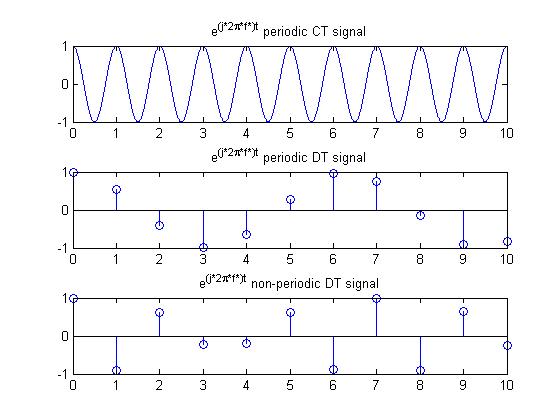(→PERIODIC AND NON-PERIODIC DT SIGNALS FROM A CT SIGNAL) |
(→PERIODIC AND NON-PERIODIC DT SIGNALS FROM A CT SIGNAL) |
||
| Line 29: | Line 29: | ||
%non - periodic DT signal | %non - periodic DT signal | ||
| − | f = pi | + | f = pi/2; |
n = 0:1:10; | n = 0:1:10; | ||
x = real(exp(j*2*pi*f*n)); | x = real(exp(j*2*pi*f*n)); | ||
| Line 35: | Line 35: | ||
stem(n,x) | stem(n,x) | ||
title('e^{(j*2\pi*f*)t} non-periodic DT signal'); | title('e^{(j*2\pi*f*)t} non-periodic DT signal'); | ||
| + | |||
</pre> | </pre> | ||
Revision as of 18:11, 12 September 2008
PERIODIC AND NON-PERIODIC DT SIGNALS FROM A CT SIGNAL
%ECE 301
%Daniel Barjum
%HW 2A
clear
clc
%periodic CT signal
f = 1;
t = 0:0.001:10;
x = real(exp(j*2*pi*f*t));
subplot(3,1,1);
plot(t,x)
title('e^{(j*2\pi*f*)t} periodic CT signal');
%periodic DT signal
f = 1/(2*pi);
n = 0:1:10;
x = real(exp(j*2*pi*f*n));
subplot(3,1,2);
stem(n,x)
title('e^{(j*2\pi*f*)t} periodic DT signal');
%non - periodic DT signal
f = pi/2;
n = 0:1:10;
x = real(exp(j*2*pi*f*n));
subplot(3,1,3);
stem(n,x)
title('e^{(j*2\pi*f*)t} non-periodic DT signal');
PART 2
MAKING A NON PERIODIC SIGNAL PERIODIC


